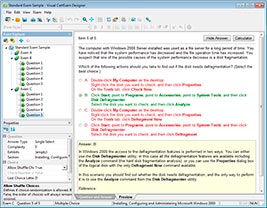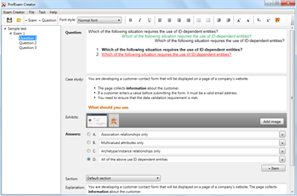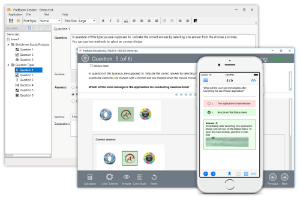Download AWS Certified SysOps Administrator - Associate.SOA-C02.VCEplus.2025-04-07.180q.vcex
| Vendor: | Amazon |
| Exam Code: | SOA-C02 |
| Exam Name: | AWS Certified SysOps Administrator - Associate |
| Date: | Apr 07, 2025 |
| File Size: | 2 MB |
How to open VCEX files?
Files with VCEX extension can be opened by ProfExam Simulator.
Purchase
Coupon: TAURUSSIM_20OFF
Discount: 20%
Demo Questions
Question 1
A company recently acquired another corporation and all of that corporation's AWS accounts. A financial analyst needs the cost data from these accounts. A SysOps administrator uses Cost Explorer to generate cost and usage reports. The SysOps administrator notices that "No Tagkey" represents 20% of the monthly cost.
What should the SysOps administrator do to tag the "No Tagkey" resources?
- Add the accounts to AWS Organizations. Use a service control policy (SCP) to tag all the untagged resources.
- Use an AWS Config rule to find the untagged resources. Set the remediation action to terminate the resources.
- Use Cost Explorer to find and tag all the untagged resources.
- Use Tag Editor to find and taq all the untaqqed resources.
Correct answer: D
Explanation:
"You can add tags to resources when you create the resource. You can use the resource's service console or API to add, change, or remove those tags one resource at a time. To add tags to--or edit or delete tags of--multiple resources at once, use Tag Editor. With Tag Editor, you search for the resources that you want to tag, and then manage tags for the resources in your search results." https://docs.aws.amazon.com/ARG/latest/userguide/tag-editor.html "You can add tags to resources when you create the resource. You can use the resource's service console or API to add, change, or remove those tags one resource at a time. To add tags to--or edit or delete tags of--multiple resources at once, use Tag Editor. With Tag Editor, you search for the resources that you want to tag, and then manage tags for the resources in your search results." https://docs.aws.amazon.com/ARG/latest/userguide/tag-editor.html
Question 2
A SysOps administrator noticed that the cache hit ratio for an Amazon CloudFront distribution is less than 10%.
Which collection of configuration changes will increase the cache hit ratio for the distribution? (Select TWO.)
- Ensure that only required cookies, query strings, and headers are forwarded in the Cache Behavior Settings.
- Change the Viewer Protocol Policy to use HTTPS only.
- Configure the distribution to use presigned cookies and URLs to restrict access to the distribution.
- Enable automatic compression of objects in the Cache Behavior Settings.
- Increase the CloudFront time to live (TTL) settings in the Cache Behavior Settings.
Correct answer: AE
Explanation:
https://docs.aws.amazon.com/AmazonCloudFront/latest/DeveloperGuide/cache-hitratio.html#cache-hit-ratio-http-streaming https://docs.aws.amazon.com/AmazonCloudFront/latest/DeveloperGuide/cache-hitratio.html#cache-hit-ratio-http-streaming
Question 3
A SysOps administrator is setting up an automated process to recover an Amazon EC2 instance in the event of an underlying hardware failure. The recovered instance must have the same private IP address and the same Elastic IP address that the original instance had.
The SysOps team must receive an email notification when the recovery process is initiated. Which solution will meet these requirements?
- Create an Amazon CloudWatch alarm for the EC2 instance, and specify the StatusCheckFailed_Instance metric. Add an EC2 action to the alarm to recover the instance. Add an alarm notification to publish a message to anAmazon Simple Notification Service (Amazon SNS) topic. Subscribe the SysOps team email address to the SNS topic.
- Create an Amazon CloudWatch alarm for the EC2 instance, and specify the StatusCheckFailed_System metric. Add an EC2 action to the alarm to recover the instance. Add an alarm notification to publish a message to anAmazon Simple Notification Service (Amazon SNS) topic. Subscribe the SysOps team email address to the SNS topic.
- Create an Auto Scaling group across three different subnets in the same Availability Zone with a minimum, maximum, and desired size of 1. Configure the Auto Scaling group to use a launch template that specifies theprivate IP address and the Elastic IP address. Add an activity notification for the Auto Scaling group to send an email message to the SysOps team through Amazon Simple Email Service (Amazon SES).
- Create an Auto Scaling group across three Availability Zones with a minimum, maximum, and desired size of 1. Configure the Auto Scaling group to use a launch template that specifies the private IP address and theElastic IP address. Add an activity notification for the Auto Scaling group to publish a message to an Amazon Simple Notification Service (Amazon SNS) topic. Subscribe the SysOps team email address to the SNS topic.
Correct answer: A
Explanation:
Reference: https://docs.aws.amazon.com/AWSEC2/latest/UserGuide/using-cloudwatch-createalarm.html Reference: https://docs.aws.amazon.com/AWSEC2/latest/UserGuide/using-cloudwatch-createalarm.html

Question 4
A company has an Amazon Route 53 private hosted zone in its AWS account. The private hosted zone is connected to the company's on-premises data center by an AWS Direct Connect connection. Virtual machines (VMs) in the on- premises data center need to resolve DNS queries that exist in the private hosted zone.
What is the MOST operationally efficient solution that meets this requirement?
- Create a Route 53 inbound resolver. Configure the on-premises VMs to use the inbound resolver.
- Create a Route 53 outbound resolver. Configure the on-premises VMs to use the outbound resolver.
- Configure the security group on the Route 53 private hosted zone by adding an inbound rule for the on-premises CIDR range.
- Configure a Route 53 public hosted zone. Create an NS record for the private hosted zone. Query the public hosted zone from the on-premises VMs.
Correct answer: D
Explanation:
Reference: https://aws.amazon.com/blogs/security/how-to-centralize-dns-management-in-a-multi-account-environment/ Reference: https://aws.amazon.com/blogs/security/how-to-centralize-dns-management-in-a-multi-account-environment/
Question 5
A development team recently deployed a new version of a web application to production. After the release, penetration testing revealed a cross-site scripting vulnerability that could expose user data. Which AWS service will mitigate this issue?
- AWS Shield Standard
- AWS WAF
- Elastic Load Balancing
- Amazon Cognito
Correct answer: B
Explanation:
Reference: https://docs.aws.amazon.com/waf/latest/developerguide/waf-rule-statement-type-xss-match.html Reference: https://docs.aws.amazon.com/waf/latest/developerguide/waf-rule-statement-type-xss-match.html
Question 6
A SysOps administrator has enabled AWS CloudTrail in an AWS account. If CloudTrail is disabled, it must be re-enabled immediately.
What should the SysOps administrator do to meet these requirements WITHOUT writing custom code?
- Add the AWS account to AWS Organizations. Enable CloudTrail in the management account.
- Create an AWS Config rule that is invoked when CloudTrail configuration changes. Apply the AWSConfigureCloudTrailLogging automatic remediation action.
- Create an AWS Config rule that is invoked when CloudTrail configuration changes. Configure the rule to invoke an AWS Lambda function to enable CloudTrail.
- Create an Amazon EventBridge (Amazon CloudWatch Event) hourly rule with a schedule pattern to run an AWS Systems Manager Automation document to enable CloudTrail.
Correct answer: B
Question 7
A Sysops administrator creates an Amazon Elastic Kubernetes Service (Amazon EKS) cluster that uses AWS Fargate. The cluster is deployed successfully. The Sysops administrator needs to manage the cluster by using the kubect1 command line tool.
Which of the following must be configured on the Sysops administrator's machine so that kubect1can communicate with the cluster API server?
- The kubeconfig file
- The kube-proxy Amazon EKS add-on
- The Fargate profile
- The eks-connector.yaml file
Correct answer: A
Explanation:
The kubeconfig file is a configuration file used to store cluster authentication information, which is required to make requests to the Amazon EKS cluster API server. The kubeconfig file will need to be configured on the SysOps administrator's machine in order for kubectl to be able to communicate with the cluster API server. https://aws.amazon.com/blogs/developer/running-a-kubernetes-job-in-amazon-eks-on-aws-fargateusing-aws-stepfunctions/ The kubeconfig file is a configuration file used to store cluster authentication information, which is required to make requests to the Amazon EKS cluster API server. The kubeconfig file will need to be configured on the SysOps administrator's machine in order for kubectl to be able to communicate with the cluster API server. https://aws.amazon.com/blogs/developer/running-a-kubernetes-job-in-amazon-eks-on-aws-fargateusing-aws-stepfunctions/
Question 8
A Sysops administrator needs to configure automatic rotation for Amazon RDS database credentials.
The credentials must rotate every 30 days. The solution must integrate with Amazon RDS.
Which solution will meet these requirements with the LEAST operational overhead?
- Store the credentials in AWS Systems Manager Parameter Store as a secure string. Configure automatic rotation with a rotation interval of 30 days.
- Store the credentials in AWS Secrets Manager. Configure automatic rotation with a rotation interval of 30 days.
- Store the credentials in a file in an Amazon S3 bucket. Deploy an AWS Lambda function to automatically rotate the credentials every 30 days.
- Store the credentials in AWS Secrets Manager. Deploy an AWS Lambda function to automatically rotate the credentials every 30 days.
Correct answer: B
Explanation:
Storing the credentials in AWS Secrets Manager and configuring automatic rotation with a rotation interval of 30 days is the most efficient way to meet the requirements with the least operational overhead. AWS Secrets Manager automatically rotates the credentials at the specified interval, so there is no need for an additional AWS Lambda function or manual rotation. Additionally, Secrets Manager is integrated with Amazon RDS, so the credentials can be easily used with the RDS database. Storing the credentials in AWS Secrets Manager and configuring automatic rotation with a rotation interval of 30 days is the most efficient way to meet the requirements with the least operational overhead. AWS Secrets Manager automatically rotates the credentials at the specified interval, so there is no need for an additional AWS Lambda function or manual rotation. Additionally, Secrets Manager is integrated with Amazon RDS, so the credentials can be easily used with the RDS database.
Question 9
A company has an application that runs only on Amazon EC2 Spot Instances. The instances run in an Amazon EC2 Auto Scaling group with scheduled scaling actions. However, the capacity does not always increase at the scheduled times, and instances terminate many times a day. A Sysops administrator must ensure that the instances launch on time and have fewer interruptions. Which action will meet these requirements?
- Specify the capacity-optimized allocation strategy for Spot Instances. Add more instance types to the Auto Scaling group.
- Specify the capacity-optimized allocation strategy for Spot Instances. Increase the size of the instances in the Auto Scaling group.
- Specify the lowest-price allocation strategy for Spot Instances. Add more instance types to the Auto Scaling group.
- Specify the lowest-price allocation strategy for Spot Instances. Increase the size of the instances in the Auto Scaling group.
Correct answer: A
Explanation:
Specifying the capacity-optimized allocation strategy for Spot Instances and adding more instance types to the Auto Scaling group is the best action to meet the requirements. Increasing the size of the instances in the Auto Scaling group will not necessarily help with the launch time or reduce interruptions, as the Spot Instances could still be interrupted even with larger instance sizes. Specifying the capacity-optimized allocation strategy for Spot Instances and adding more instance types to the Auto Scaling group is the best action to meet the requirements. Increasing the size of the instances in the Auto Scaling group will not necessarily help with the launch time or reduce interruptions, as the Spot Instances could still be interrupted even with larger instance sizes.
Question 10
A company stores its data in an Amazon S3 bucket. The company is required to classify the data and find any sensitive personal information in its S3 files.
Which solution will meet these requirements?
- Create an AWS Config rule to discover sensitive personal information in the S3 files and mark them as noncompliant.
- Create an S3 event-driven artificial intelligence/machine learning (AI/ML) pipeline to classify sensitive personal information by using Amazon Recognition.
- Enable Amazon GuardDuty. Configure S3 protection to monitor all data inside Amazon S3.
- Enable Amazon Macie. Create a discovery job that uses the managed data identifier.
Correct answer: D
Explanation:
Amazon Macie is a security service designed to help organizations find, classify, and protect sensitive data stored in Amazon S3. Amazon Macie uses machine learning to automatically discover, classify, and protect sensitive data in Amazon S3. Creating a discovery job with the managed data identifier will allow Macie to identify sensitive personal information in the S3 files and classify it accordingly. Enabling AWS Config and Amazon GuardDuty will not help with this requirement as they are not designed to automatically classify and protect data. Amazon Macie is a security service designed to help organizations find, classify, and protect sensitive data stored in Amazon S3. Amazon Macie uses machine learning to automatically discover, classify, and protect sensitive data in Amazon S3. Creating a discovery job with the managed data identifier will allow Macie to identify sensitive personal information in the S3 files and classify it accordingly. Enabling AWS Config and Amazon GuardDuty will not help with this requirement as they are not designed to automatically classify and protect data.
Question 11
A company wants to apply an existing Amazon Route 53 private hosted zone to a new VPC to allow for customized resource name resolution within the VPC. The Syspps administrator created the VPC and added the appropriate resource record sets to the private hosted zone.
Which step should the SysOps administrator take to complete the setup?
- Associate the Route 53 private hosted zone with the VPC.
- Create a rule in the default security group for the VPC that allows traffic to the Route 53 Resolver.
- Ensure the VPC network ACLs allow traffic to the Route 53 Resolver.
- Ensure there is a route to the Route 53 Resolver in each of the VPC route tables.
Correct answer: A
Explanation:
https://docs.aws.amazon.com/Route53/latest/DeveloperGuide/hosted-zones-private.htmlTo apply an existing Amazon Route 53 private hosted zone to a new VPC, the appropriate step is to associate the private hosted zone with the new VPC. This allows the resources within the VPC to use the custom DNS settings defined in the private hosted zone. Option A is the correct step to ensure that DNS queries from the new VPC are resolved using the specified private hosted zone. Detailed steps for this process can be found in the AWS Route 53 documentation on associating hosted zones with VPCs Associating Hosted Zones with VPCs. https://docs.aws.amazon.com/Route53/latest/DeveloperGuide/hosted-zones-private.html
To apply an existing Amazon Route 53 private hosted zone to a new VPC, the appropriate step is to associate the private hosted zone with the new VPC. This allows the resources within the VPC to use the custom DNS settings defined in the private hosted zone. Option A is the correct step to ensure that DNS queries from the new VPC are resolved using the specified private hosted zone. Detailed steps for this process can be found in the AWS Route 53 documentation on associating hosted zones with VPCs Associating Hosted Zones with VPCs.
HOW TO OPEN VCE FILES
Use VCE Exam Simulator to open VCE files

HOW TO OPEN VCEX FILES
Use ProfExam Simulator to open VCEX files


ProfExam at a 20% markdown
You have the opportunity to purchase ProfExam at a 20% reduced price
Get Now!



